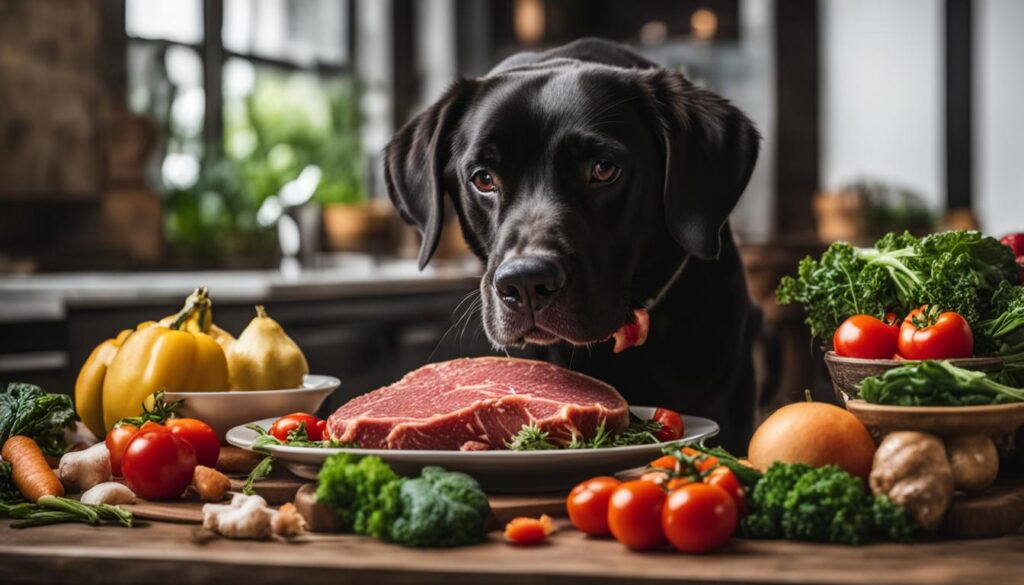Welcome to the world of BARF diet for dogs! If you’re looking for a natural and unprocessed way to feed your furry friend, you’ve come to the right place. The BARF diet, also known as Biologically Appropriate Raw Food, is gaining popularity among pet owners who want to provide their dogs with a balanced and nutritious diet. Say goodbye to artificial additives and flavors found in commercial pet foods and say hello to a healthier and happier pup!
Key Takeaways:
- BARF diet is a natural and unprocessed way of feeding dogs.
- It consists of raw meats, organs, bones, vegetables, and fruits.
- Switching to a BARF diet can improve overall health, digestion, and immune system function.
- Protein and fat are crucial components of a BARF diet.
- Calcium from raw edible bones is important for dogs’ skeletal health.
Protein & Fat Rule
When it comes to the BARF diet for dogs, the rule of thumb is that protein and fat are king. These two nutrients play crucial roles in providing dogs with the energy and essential building blocks their bodies need to thrive. Protein is not only a source of energy but also helps support the growth and repair of tissues in the body. Fat, on the other hand, serves as a concentrated source of energy and aids in various physiological processes.
In a BARF diet, it is important to maintain a balanced ratio of protein and fat. The fat content should typically be between 10% and 20% of the dog’s overall diet, including any additional oils added to their meals. However, it’s important to note that carbohydrates are not essential for dogs and can be excluded or minimized in a BARF diet.
In summary, protein and fat are the key players in a BARF diet for dogs. They provide essential nutrients for energy, tissue building, and overall physiological processes. By ensuring the right balance of protein and fat, you can help support your dog’s health and well-being.
| Protein | Fat |
|---|---|
| Source of energy | Concentrated energy source |
| Aids in tissue growth and repair | Supports various physiological processes |
| Essential building block for the body | Provides necessary nutrients |
Quote:
“Protein and fat are the powerhouses of the BARF diet. They provide dogs with the energy and essential building blocks they need to thrive.”
Benefits of Protein and Fat in a BARF Diet:
- Supports energy levels
- Aids in tissue growth and repair
- Provides essential nutrients for overall health
- Supports various physiological processes
- Promotes a healthy coat and skin
By prioritizing protein and fat in your dog’s BARF diet, you can ensure that they receive the necessary nutrients to support their overall health and well-being.

Calcium Rule
Calcium plays a crucial role in a dog’s diet, and it is essential to include the right amount of calcium-rich bone in a BARF diet. Raw edible bone provides dogs with not only calcium but also minerals like phosphorus, magnesium, and zinc. To ensure a steady supply of calcium and support healthy bone development, a BARF diet for dogs should include approximately 10% to 15% raw edible bone.
Feeding whole meaty bones such as chicken necks, wings, or duck feet can help fulfill the calcium requirement. However, it is important to choose bones that are appropriate for the size of the dog to prevent choking or tooth damage. Remember, dogs need a sufficient amount of calcium to maintain strong bones, so including raw bone in their diet is crucial.
“Calcium is an essential nutrient for dogs and is important for their bone health. Including raw edible bone in their diet provides them with the necessary calcium and other minerals.”
Table: Calcium-Rich Bone Sources for a BARF Diet
| Bone Source | Calcium Content (%) | Additional Minerals |
|---|---|---|
| Chicken Necks | 17.9 | Phosphorus, Magnesium, Zinc |
| Chicken Wings | 14.6 | Phosphorus, Magnesium, Zinc |
| Duck Feet | 26.7 | Phosphorus, Magnesium, Zinc |
Ensuring Proper Bone Size
When selecting bones for your dog’s BARF diet, it’s important to choose ones that are appropriate for their size and chewing capabilities. Larger dogs may need larger bones, such as beef knuckles or femur bones, while smaller dogs may prefer chicken necks or wings. Providing bones that are too small can pose a choking hazard, while bones that are too large could cause tooth fractures. Always supervise your dog while they are chewing on bones to ensure their safety.
Raw Feeding for Puppies
Puppies have unique nutritional needs during their growth and development, and the BARF diet can offer significant benefits for their overall well-being. By providing puppies with a raw and natural diet, you can ensure they receive the essential nutrients necessary for optimal growth.
When feeding puppies on a BARF diet, it is recommended to feed them up to 10% of their current body weight or 2-3% of their expected adult body weight. This helps ensure they receive adequate nutrition without the risk of overfeeding. Monitoring their growth and adjusting the diet accordingly is crucial to avoid excessive weight gain or nutrient deficiencies.
“Feeding puppies a BARF diet can promote healthy skeletal growth and development of adult teeth.”
One key aspect of a BARF diet for puppies is providing them with a steady supply of calcium, which is essential for their skeletal growth. Raw edible bones, such as chicken necks, wings, or duck feet, can be included in their meals to fulfill this calcium requirement. It’s important to select bones that are appropriate for the size of the puppy to prevent choking or tooth damage.
Benefits of the BARF diet for puppies:
- Supports healthy growth and development
- Promotes strong bones and teeth
- Enhances digestion and nutrient absorption
- Boosts immune system function
- Improves coat and skin health

| Benefits of BARF Diet for Puppies |
|---|
| Supports healthy growth and development |
| Promotes strong bones and teeth |
| Enhances digestion and nutrient absorption |
| Boosts immune system function |
| Improves coat and skin health |
Switching to a BARF diet for puppies can provide them with the necessary nutrients for optimal growth and development. By following the guidelines and ensuring a balanced diet, you can give your puppy the best start in life.
Transitioning to a BARF Diet
Transitioning your dog to a BARF diet can be a process that requires careful planning and gradual adjustments. It’s important to introduce the new diet slowly over a period of approximately 7 days to allow your dog’s digestive system to adapt. This is particularly true for senior dogs, those with allergies, or dogs who are used to a commercial diet. Making the switch too quickly can lead to stomach upsets and digestive issues.
During the transition period, gradually increase the proportion of raw food in your dog’s diet while decreasing the proportion of their current food. Start by replacing a small portion of their regular food with raw food, and then gradually increase the amount over the course of a week. Keep a close eye on your dog’s digestion during this time, and if any issues arise, adjust the proportions or ingredients as necessary.
Remember to monitor your dog’s overall health and well-being throughout the transition. Look out for any changes in their energy levels, coat condition, and stool consistency. If you notice any negative changes, consult with your veterinarian or a pet nutritionist to ensure your dog is receiving the necessary nutrients and adjustments can be made accordingly.

Benefits of Transitioning to a BARF diet
Switching to a BARF diet offers numerous benefits for your dog’s overall health and well-being. The natural and unprocessed nature of the diet provides dogs with essential nutrients and eliminates the additives and artificial flavors found in commercial pet foods.
- Improved overall health: A BARF diet can support improved digestion, immune system function, and gut health in dogs.
- Healthy weight management: The controlled proportions of protein and fat in a BARF diet help maintain a healthy weight for dogs.
- Enhanced coat condition: The nutrient-rich raw food in a BARF diet can lead to a shinier and healthier coat for your dog.
- Increased energy levels: The natural and balanced nutrition of a BARF diet can provide dogs with increased energy and vitality.
- Reduced allergy symptoms: Some dogs with food allergies or sensitivities may experience relief by switching to a BARF diet.
By transitioning your dog to a BARF diet, you are providing them with a diet that closely mimics what they would consume in the wild, promoting optimal health and a longer, happier life.
Raw Meat Sources for BARF
When it comes to feeding your dog a BARF diet, high-quality raw meat is essential. It provides dogs with the necessary proteins and nutrients they need to thrive. Here are some excellent sources of raw meat for your dog’s BARF diet:
1. Chicken:
Chicken is a popular choice for BARF diets. It is readily available, affordable, and provides dogs with lean protein. When feeding chicken, include a variety of cuts such as wings, necks, or feet to provide different textures and nutritional benefits.
2. Beef:
Beef is another great option for a BARF diet. It is rich in protein and iron, which supports the overall health and wellbeing of dogs. Choose lean cuts like ground beef or beef heart to provide essential nutrients for your furry friend.
3. Fish:
Incorporating fish into your dog’s BARF diet can offer additional benefits. Fish, such as salmon or sardines, are high in omega-3 fatty acids, which promote healthy skin and coat. Ensure that the fish is fresh and free from any bones. Fish can be fed cooked or raw, depending on your dog’s preferences.
4. Lamb:
Lamb is a nutritious source of protein for dogs. It contains essential amino acids and vitamins that promote muscle growth and support the immune system. Lamb can be fed as ground meat or in cuts like shoulder or loin.
“Feeding your dog a BARF diet with high-quality raw meat ensures they receive the necessary nutrients and supports their overall health and wellbeing.”
Remember that each dog is unique, and their dietary needs may vary. It’s important to consult with a veterinarian or pet nutritionist to determine the best raw meat sources and proportions for your dog’s individual needs. By providing a variety of raw meat options, you can ensure a balanced and nutritious BARF diet for your canine companion.
BARF Diet Supplements
While a properly balanced BARF diet can provide most of the necessary nutrients for dogs, some pet owners may choose to supplement their dog’s diet with additional vitamins and minerals. Supplements can offer nutritional support and address specific health concerns in dogs. Here are some essential supplements that you may consider for your dog on a BARF diet:
Fish Oil
One beneficial supplement for dogs on a BARF diet is fish oil. Fish oil is rich in omega-3 fatty acids, which provide numerous health benefits for dogs. Omega-3 fatty acids support healthy skin and coat, reduce inflammation, and promote cardiovascular health. Adding fish oil to your dog’s diet can help maintain a shiny, lustrous coat and alleviate skin irritations.
Probiotics and Digestive Enzymes
Probiotics and digestive enzymes can also be beneficial supplements for dogs on a BARF diet. Probiotics help promote a healthy gut flora, aiding in digestion and nutrient absorption. They can be especially helpful for dogs with sensitive stomachs or those prone to digestive issues. Digestive enzymes support efficient digestion and can be particularly useful for dogs with pancreatic insufficiency or those experiencing difficulty digesting certain foods.
When considering adding supplements to your dog’s diet, it’s essential to consult with a veterinarian or pet nutritionist. They can assess your dog’s specific needs and recommend appropriate supplements based on their age, breed, health condition, and dietary requirements. Remember that supplements should not replace a properly balanced BARF diet but rather complement it to provide optimal nutritional support and promote your dog’s overall well-being.
Conclusion
The BARF diet for dogs offers a natural and wholesome approach to feeding your furry friends. By following the guidelines and principles of the BARF diet, you can ensure that your dogs receive the balanced nutrition they need to thrive.
With a focus on raw, unprocessed ingredients like meats, organs, bones, vegetables, and fruits, the BARF diet provides dogs with the essential nutrients they require, without the additives and artificial flavors found in commercial pet foods.
By switching to a BARF diet, you can potentially improve your dog’s overall health, digestion, and immune system function. Providing them with the right balance of proteins, fats, calcium, and other important nutrients can contribute to their overall well-being.
Remember, transitioning to a BARF diet should be done gradually, and it’s important to monitor your dog’s digestion and adjust accordingly. Whether you’re looking to give your dog a more natural and biologically appropriate diet or address specific health concerns, the BARF diet can have numerous benefits for your furry companion.
FAQ
Can I feed my dog a BARF diet without including carbohydrates?
Yes, carbohydrates are not essential for dogs and can be excluded or minimized in a BARF diet. The diet primarily consists of raw meats, organs, bones, vegetables, and fruits.
How much fat should be included in a BARF diet for dogs?
It’s important to maintain a fat content between 10% and 20% in a BARF diet for dogs. This includes any additional oils added to their meals.
How much bone should be included in a BARF diet for dogs?
Approximately 10% to 15% of raw edible bone should be included in a BARF diet for dogs to ensure a steady supply of calcium and other important minerals. Feeding whole meaty bones like chicken necks, wings, or duck feet can help fulfill this requirement.
Is the BARF diet suitable for puppies?
Yes, the BARF diet can be beneficial for the growth and development of puppies. It’s important to provide them with a steady supply of calcium from bone to support their skeletal growth and development of adult teeth.
How should I transition my dog to a BARF diet?
Transitioning to a BARF diet should be done gradually over approximately 7 days. It involves gradually increasing the proportion of raw food in the dog’s diet while decreasing the proportion of their current food. Monitor your dog’s digestion and make any necessary adjustments during the transition period.
What are the best raw meat sources for a BARF diet?
Meat options for a BARF diet include chicken, lamb, pork, beef, turkey, and various types of fish. It’s important to choose fresh meat without hormones or antibiotics and to provide a variety of protein sources for a balanced diet.
Should I supplement my dog’s BARF diet with additional vitamins and minerals?
While a properly balanced BARF diet can provide most of the necessary nutrients, some pet owners may choose to supplement their dog’s diet with additional vitamins and minerals. It’s important to consult with a veterinarian or pet nutritionist before adding any supplements to ensure they are appropriate for your dog’s specific needs.





